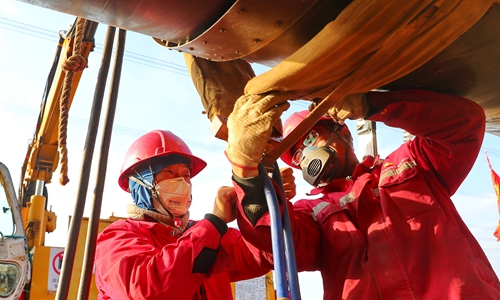China imports 1.58 bln cubic meters of natural gas via landmark pipeline from Russia
Source:Xinhua Published: 2020/6/4 13:50:52

Workers install medium-frequency heating for the China-Russia east-route natural gas pipeline on Wednesday in Qinhuangdao, North China’s Hebei Province. The pipeline began operating in December 2019. The project is scheduled to provide China with 5 billion cubic meters of Russian gas in 2020, rising to 38 billion cubic meters annually from 2024. Photo: cnsphotos
Heihe Customs in northeast China's Heilongjiang Province has supervised the importation of 1.58 billion cubic meters of natural gas via the China-Russia east-route natural gas pipeline over the past six months.
The cross-border gas pipeline has a 3,000-km section in Russia and a 5,111-km stretch in China.
On Dec. 2, 2019, a 1,067-km section of the northern part of the pipeline was officially put into operation, marking the start of a new era in bilateral energy cooperation.
Entering China via the border city of Heihe and running through nine provinces, municipalities and autonomous regions, the pipeline has also been connected with existing natural gas networks in China to allow the Russian natural gas supply to reach China's northeast, Beijing-Tianjin-Hebei and the Yangtze River Delta region.
The pipeline is scheduled to provide China with 5 billion cubic meters of Russian gas in 2020 and the amount is expected to increase to 38 billion cubic meters annually from 2024, under a 30-year contract worth 400 billion US dollars signed between the China National Petroleum Corp (CNPC) and Russian gas giant Gazprom in May 2014.
Posted in: INDUSTRIES